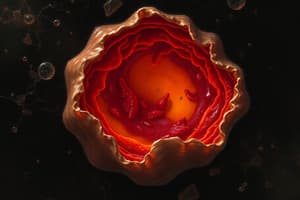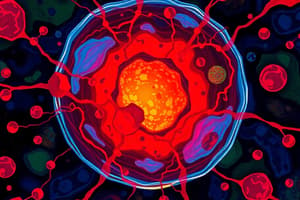Podcast
Questions and Answers
What primarily causes fat necrosis following acute pancreatitis?
What primarily causes fat necrosis following acute pancreatitis?
- Increased fatty acid synthesis
- Direct tissue injury from digestive enzymes
- Release of activated pancreatic enzymes (correct)
- Decreased blood flow to fat cells
Which of the following processes is NOT associated with apoptosis?
Which of the following processes is NOT associated with apoptosis?
- Development of tumors induced by growth factors (correct)
- Programmed cell death during embryogenesis
- Hormone-dependent involution in the endometrium
- Cell deletion in proliferating intestinal epithelium
What morphological change is typically observed in cells undergoing apoptosis?
What morphological change is typically observed in cells undergoing apoptosis?
- Formation of multinucleated giant cells
- Cell swelling and rupture
- Condensed nuclear chromatin (correct)
- Cytoplasmic vacuolation
Which factor is NOT typically involved in the initiation of apoptosis?
Which factor is NOT typically involved in the initiation of apoptosis?
What defines the category of storage diseases in the context of intracellular accumulations?
What defines the category of storage diseases in the context of intracellular accumulations?
What is a primary distinguishing feature of apoptosis compared to necrosis?
What is a primary distinguishing feature of apoptosis compared to necrosis?
In terms of histological appearance, how do apoptotic cells typically present in H&E stains?
In terms of histological appearance, how do apoptotic cells typically present in H&E stains?
What role do endonucleases play in the process of apoptosis?
What role do endonucleases play in the process of apoptosis?
What type of tumor is characterized by divergent differentiation into all embryonic layers?
What type of tumor is characterized by divergent differentiation into all embryonic layers?
Which characteristic does NOT distinguish benign tumors from malignant tumors?
Which characteristic does NOT distinguish benign tumors from malignant tumors?
What is the primary function of tumor markers in clinical practice?
What is the primary function of tumor markers in clinical practice?
What is dystrophic calcification characterized by?
What is dystrophic calcification characterized by?
Which method is NOT typically used for laboratory diagnosis of tumors?
Which method is NOT typically used for laboratory diagnosis of tumors?
What type of tumor has cells that are poorly or completely undifferentiated?
What type of tumor has cells that are poorly or completely undifferentiated?
Which condition may lead to metastatic calcification in normal tissues?
Which condition may lead to metastatic calcification in normal tissues?
What causes atrophy in cells?
What causes atrophy in cells?
Which role does molecular profiling of tumors play in cancer treatment?
Which role does molecular profiling of tumors play in cancer treatment?
Which of the following tumors would be classified as having an epithelial origin?
Which of the following tumors would be classified as having an epithelial origin?
Which of the following correctly describes hypertrophy?
Which of the following correctly describes hypertrophy?
What is a common characteristic of malignant tumors in terms of their growth pattern?
What is a common characteristic of malignant tumors in terms of their growth pattern?
What is a common consequence of extensive nephrocalcinosis?
What is a common consequence of extensive nephrocalcinosis?
Which of the following processes may involve apoptotic death?
Which of the following processes may involve apoptotic death?
In which tissues is metastatic calcification most likely to occur?
In which tissues is metastatic calcification most likely to occur?
Which of the following is NOT a cause of hypercalcemia?
Which of the following is NOT a cause of hypercalcemia?
What characterizes the immediate phase of a Type I hypersensitivity reaction?
What characterizes the immediate phase of a Type I hypersensitivity reaction?
Which mechanism does NOT participate in Type II hypersensitivity reactions?
Which mechanism does NOT participate in Type II hypersensitivity reactions?
Which of the following conditions is an example of a Type III hypersensitivity reaction?
Which of the following conditions is an example of a Type III hypersensitivity reaction?
What is the primary purpose of the grading system in tumors?
What is the primary purpose of the grading system in tumors?
Which of the following statements about Type IV hypersensitivity is correct?
Which of the following statements about Type IV hypersensitivity is correct?
Which of the following best describes innate immunity?
Which of the following best describes innate immunity?
What causes tissue damage in Type III hypersensitivity reactions?
What causes tissue damage in Type III hypersensitivity reactions?
In the TNM staging system, what does the 'N' represent?
In the TNM staging system, what does the 'N' represent?
What describes the role of T-lymphocytes in the immune system?
What describes the role of T-lymphocytes in the immune system?
Which response is typical of the late phase of a Type I hypersensitivity reaction?
Which response is typical of the late phase of a Type I hypersensitivity reaction?
Which of the following antigens is not classified as a tumor-associated antigen?
Which of the following antigens is not classified as a tumor-associated antigen?
Which of the following diseases is associated with a Type II hypersensitivity reaction?
Which of the following diseases is associated with a Type II hypersensitivity reaction?
What distinguishes cellular immunity from humoral immunity?
What distinguishes cellular immunity from humoral immunity?
What characterizes the CD3 complex associated with T cells?
What characterizes the CD3 complex associated with T cells?
In the context of grading tumors, what does an increase in anaplasia indicate?
In the context of grading tumors, what does an increase in anaplasia indicate?
In a Type II hypersensitivity reaction, what role do antibodies play?
In a Type II hypersensitivity reaction, what role do antibodies play?
Flashcards are hidden until you start studying
Study Notes
### Necrosis
-
Caseous Necrosis: This type of necrosis is characterized by amorphous granular debris within granulomatous inflammation.
-
Fat Necrosis: This occurs when pancreatic enzymes, released during acute pancreatitis, break down fat cells in the peritoneal cavity.
Apoptosis
- Apoptosis is the programmed death of cells, which can happen in both healthy and diseased conditions
- Apoptosis usually affects single cells or small clusters of cells.
- During apoptosis, the nucleus shows condensation of chromatin, which then fragments.
- This process involves the activation of endonucleases, leading to cell shrinkage, budding, and fragmentation into apoptotic bodies.
- It is important to note that apoptosis does not trigger an inflammatory response.
- Apoptosis can be initiated by several stimuli, including:
- Withdrawal of growth factors or hormones
- Engagement of specific receptors like FAS and TNF
- Injury caused by radiation, toxins, or free radicals
- Intrinsic protease activation
Intracellular Accumulations
- Cells may accumulate abnormal substances, both temporarily or permanently, which can be harmful or injurious. These accumulations can occur in the cytoplasm or nucleus.
- The accumulated substances might be produced by the affected cell itself or originate elsewhere.
- The accumulation can be classified into three main categories:
- Normal endogenous substances: Occur when the production rate of a normal substance exceeds its metabolism. An example is fatty change in the liver.
- Normal or abnormal endogenous substances: These accumulate when a genetic enzymatic defect prevents their metabolism, leading to storage diseases.
- Deposition in dead or dying tissues: This is known as dystrophic calcification which occurs even with normal calcium levels in the blood. Dystrophic calcification is often seen in areas of necrosis like atheromas in advanced atherosclerosis, areas of intimal injury in large arteries, in aging tissues, and in aortic valves.
Metastatic Calcification
- Metastatic calcification happens in normal tissues when there is hypercalcemia.
- Hypercalcemia can be caused by:
- Primary endocrine dysfunction: For example, hyperparathyroidism.
- Tumors: Tumors that increase bone catabolism, such as multiple myeloma, metastatic cancer, and leukemia.
- Ingested exogenous substances: This includes vitamin D intoxication or milk alkali syndrome.
- Sarcoidosis
- Advanced renal failure: Here, phosphate retention leads to secondary hyperparathyroidism.
- Metastatic calcification commonly occurs in interstitial tissues, kidneys, lungs, and gastric mucosa.
- It is important to note that while widespread, metastatic calcification usually doesn't significantly impair organ function. However, extensive nephrocalcinosis can lead to functional impairment.
Cellular Adaptations
-
Atrophy: This represents a shrinkage of cells due to a loss of cell substance, which can affect entire organs. Atrophic cells have diminished function but are not dead.
-
Causes of atrophy include:
- Decreased workload
- Loss of innervation
- Diminished blood supply
- Inadequate nutrition
- Loss of endocrine stimulation
- Aging
-
Biochemically, atrophy is characterized by decreased synthesis of cellular components and increased catabolism (breakdown).
-
Hypertrophy: This involves an increase in the size of cells due to an increase in the synthesis of structural proteins and organelles. This results in an increase in the size of the affected organ.
-
Hypertrophy is often caused by increased functional demands or hormonal stimulation. For example, muscle hypertrophy due to exercise or the enlargement of the heart in response to high blood pressure.
-
In some cases, the specific receptors for certain ligands expressed by endothelial cells at metastatic sites could explain the organ tropism observed in tumors.
Nomenclature of Malignant Tumors
- Mesenchymal origin: Malignant tumors originating from mesenchymal tissues (such as connective tissue and muscle) are called sarcomas. Examples include fibrosarcoma, chondrosarcoma, and leiomyosarcoma.
- Epithelial origin: Malignant tumors originating from epithelial tissues (derived from all three germ layers - ectoderm, mesoderm, and endoderm) are called carcinomas. Examples include squamous cell carcinoma and adenocarcinoma.
- Two components (mesenchymal and epithelial): Tumors that have both mesenchymal and epithelial components are called teratomas. These tumors exhibit divergent differentiation into all embryonic layers and are commonly found in the ovaries and testes. They can be either benign or malignant.
Characteristics of Benign and Malignant Tumors
-
Benign tumors:
- Resemble the tissue of origin and are well differentiated (they look similar to the normal tissue they originated from).
- Grow slowly.
- Well-circumscribed and often have a capsule surrounding them.
- Remain localized at the site of origin.
-
Malignant tumors (cancers):
- Often poorly or completely undifferentiated (anaplastic), meaning they look very different from the normal tissues.
- Grow faster than benign tumors.
- Poorly circumscribed and invade surrounding normal tissues.
- Locally invasive and can spread to distant sites through metastasis.
Laboratory Diagnosis of Cancer
-
Several methods for sampling tumors exist, including:
- Excision: Removal of the entire tumor.
- Biopsy: Removal of a small sample of tissue for examination.
- Fine-needle aspiration: Use of a thin needle to collect cells from the tumor.
- Cytologic smears: Collection of cells from a suspected tumor for microscopic analysis.
-
Immunohistochemistry and flow cytometry: These techniques can be used to identify specific proteins expressed by tumor cells, aiding in diagnosis and classification.
-
Tumor markers: These are proteins released by tumors into the serum, and their levels can be used to:
- Screen populations at risk for certain cancers
- Monitor the success of tumor treatment
- Detect recurrence of the tumor
-
Molecular analyses: These are used for:
- Diagnosis
- Prognosis
- Detection of minimal residual disease
- Diagnosis of hereditary predisposition to cancer
-
Molecular profiling: Includes cDNA arrays and sequencing, which analyze large segments of the genome and can identify mutations. This information can be used for:
- Molecular stratification of tumors, providing a more precise understanding of the tumor's behavior and guiding treatment strategies.
Tumor Antigens (Tumor Markers)
- Tumor-specific antigens: These antigens are unique to tumors and can be valuable targets for cancer therapy. Examples include the melanoma-associated antigen-1 (MAGE-1) and certain markers found in pancreatic and breast carcinomas (CA-125, CA-119).
- Tumor-associated antigens: These are shared by both normal and tumor cells. Examples include prostate-specific antigen (PSA), alpha-fetoprotein (AFP) in hepatocellular carcinoma, and carcinoembryonic antigen (CEA) in colorectal carcinomas.
Grading and Staging
- Grading: This process assesses the degree of differentiation of tumor cells and the mitotic activity (cell division rate) within the tumor. Higher grades indicate poorer differentiation and faster growth.
- Tumors are generally graded as I, II, III, or IV (with IV being the most aggressive).
- Staging: It describes the extent of the tumor, including:
- The size of the primary tumor.
- The spread to regional lymph nodes.
- The presence or absence of distant metastases.
- The TNM staging system provides a standardized approach to staging:
- T: Tumor size.
- N: Lymph node metastases.
- M: Distant metastases.
The Immune System
-
Innate immunity: This is our natural defense system, present from birth. It includes:
- Physical barriers: Like skin and mucous membranes.
- Phagocytic cells: Neutrophils and macrophages that engulf and destroy pathogens.
- Natural killer (NK) cells: These cells kill infected cells and cancer cells.
- Complement system: A group of proteins in blood that help destroy pathogens.
-
Adaptive immunity: This system develops over time in response to exposure to foreign substances (antigens).
- Cell-mediated immunity: Mediated by T lymphocytes and responsible for defense against intracellular pathogens.
- Humoral immunity: Mediated by B lymphocytes and their secreted antibodies (also called immunoglobulins). Humoral immunity primarily targets extracellular pathogens and their toxins.
Cells of the Immune System:
- T lymphocytes:
- Make up 60-70% of circulating lymphocytes.
- Found in the paracortical area of lymph nodes and periarteriolar sheath of the spleen.
- Each T cell has a unique T cell receptor (TCR) responsible for recognizing specific antigens.
- TCR is made of two polypeptide chains, α and β, linked by a disulfide bond. Each chain has a variable region (for antigen binding) and a constant region.
- The TCR is attached to a CD3 complex, involved in signal transduction.
- The diversity of TCRs is achieved through somatic rearrangement during T cell development.
- T lymphocytes express either CD4 or CD8, but not both. These co-receptors are essential for T cell function.
- CD4+ helper T cells interact with Class II MHC molecules, which present exogenous antigens (e.g., from extracellular pathogens).
- CD8+ cytotoxic T cells interact with Class I MHC molecules, which present endogenous antigens (e.g., from intracellular pathogens).
Hypersensitivity Reactions
- Hypersensitivity reactions are exaggerated immune responses that can lead to tissue damage. They are classified into four types based on their mechanisms:
- Type I (immediate) hypersensitivity:
- Occurs rapidly (within minutes) after exposure to an antigen in sensitized individuals.
- Mediated by IgE antibodies bound to mast cells.
- Involves two phases:
- Immediate phase: Rapid release of vasoactive amines from mast cells, causing vasodilation and edema.
- Late phase: Infiltration of leukocytes, leading to inflammation; seen in conditions like bronchial asthma and allergic rhinitis.
- Type II (antibody-dependent) hypersensitivity:
- Antibodies bind to antigens on cell surfaces or extracellular matrix.
- Can lead to cell destruction through:
- Opsonization and phagocytosis: Antibodies coat the antigen, facilitating recognition and engulfment by phagocytic cells.
- Antibody-dependent cellular cytotoxicity (ADCC): Antigen-bound antibodies activate NK cells and other cytotoxic cells to kill target cells.
- Antibody-mediated cellular dysfunction: Antibodies interfere with the function of cells, like in myasthenia gravis and Grave's disease.
- Examples include transfusion reactions, autoimmune hemolytic anemia, and drug reactions
- Type III (immune complex-mediated) hypersensitivity:
- Antigen-antibody complexes form and deposit in various tissues, often in blood vessels.
- The complexes trigger inflammation at the site of deposition, leading to tissue damage.
- Examples include systemic lupus erythematosus, polyarteritis nodosa, poststreptococcal glomerulonephritis, and serum sickness.
- Type IV (cell-mediated) hypersensitivity:
- Initiated by antigen-activated T lymphocytes.
- Also known as delayed-type hypersensitivity because the reaction takes 1-3 days to develop.
- Examples include contact dermatitis, tuberculin skin test, and autoimmune diseases such as rheumatoid arthritis.
- Type I (immediate) hypersensitivity:
Studying That Suits You
Use AI to generate personalized quizzes and flashcards to suit your learning preferences.




